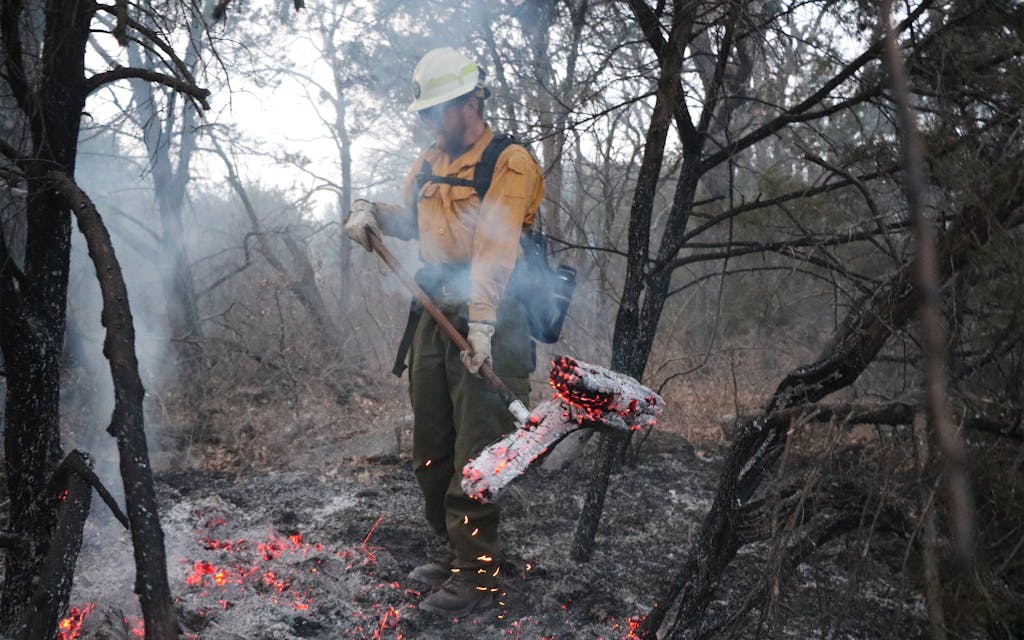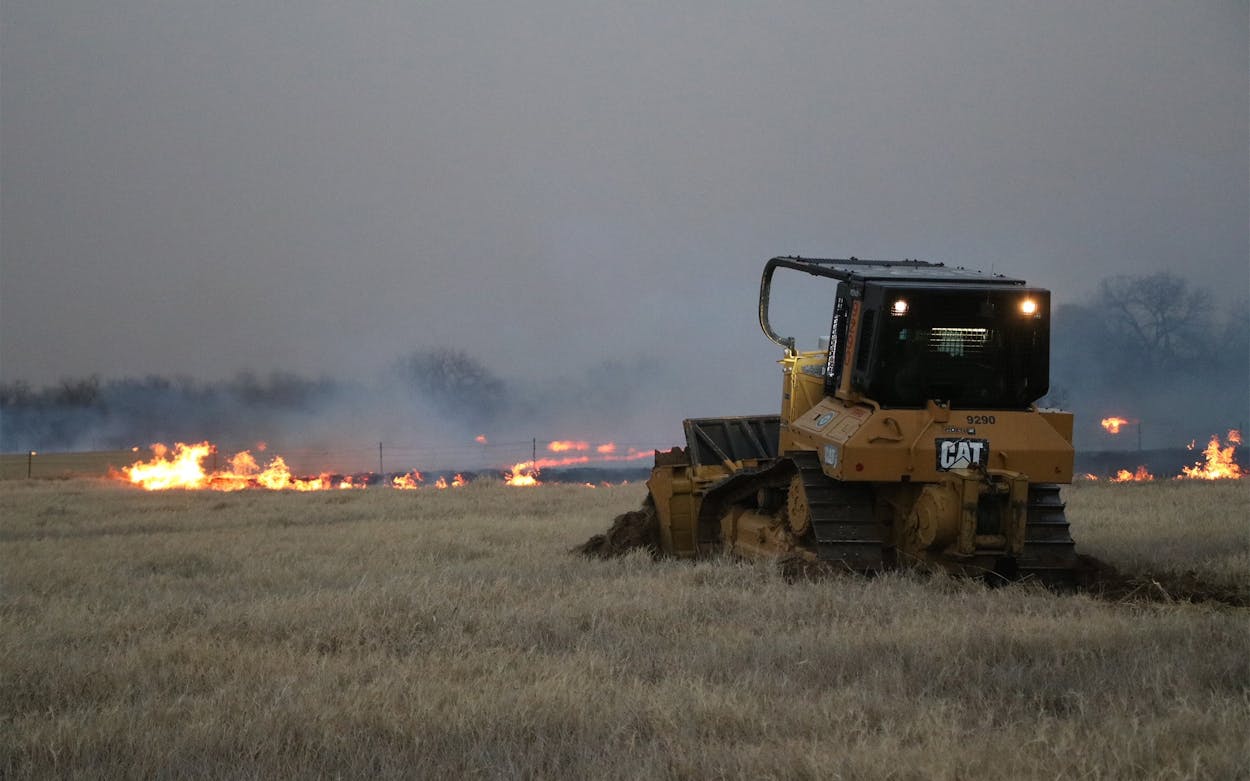Wes Moorehead spent all day Tuesday in the emergency operations center of the Texas A&M Forest Service in College Station, surveying satellite photos of 24 wildfires across the state. Two dozen fires is much higher than average for a February day in Texas, but Moorehead wasn’t surprised. He had foreseen this, since weather conditions Monday were dry and windy, ideal conditions for a burn. Throughout the day, he coolly orchestrated a response to all the active burns, dispatching personnel, aircrafts, fire dozers, and fire engines across the state.
It’s been an unusually busy year for Moorehead. Texas has had twice as many fires through mid-February as in an average year. As of February 15, 270 wildfires have burned more than 23,000 acres, both numbers the highest for this point in the year since 2017, and significantly higher than the figures for this time in 2011, a year infamous for fires that devastated the Lone Star State. That year, Moorehead was on the ground about forty miles southwest of Texarkana, fighting the Bear Creek Fire, the largest in East Texas history. He says he learned from the experience just how destructive fires can be in Texas—the fire ran rampant for 51 days, burned 66 homes, and scorched more than 40,000 acres. Though this year is off to a rough start, Moorehead sees reason for hope: He says the state is better prepared this time.
To understand more about this year’s fires, and how to prevent them, Texas Monthly spoke with Moorehead, the associate director and fire chief at Texas A&M Forest Service. This interview has been edited for length and clarity.
Texas Monthly: What did January look like in terms of wildfires?
Wes Moorehead: In January 2022, Texas A&M Forest Service responded to 159 wildfires that burned 11,873 acres. That’s double the number of wildfires we would typically respond to in an average January. We would have expected around 80. In terms of acres burned, we’re above our normal average, but not double.
Last spring and summer, we had a lot of rain, particularly in the western half of the state. All of that rain contributed to vigorous grass growth, and when you have that kind of fuel load we expect fire occurrence to be bad. So, we took some proactive measures. We pre-positioned resources across the state, including suppression aircrafts [planes that carry water or fire retardant]. Those aircrafts can knock those fires down rapidly, allowing our ground resources time to get on scene to suppress them fully.
TM: In addition to the increased fuel load, are there any other reasons why this year has been so bad?
WM: In addition to grass growth, the faucet just turned off after a wet spring and summer. We haven’t gotten the precipitation expected, and drought conditions have established themselves in the state. That, combined with really tall grass, surged the number of fires that we’ve seen over the last month.
TM: Are there any specific parts of Texas that are considered wildfire hot spots?
WM: There are not necessarily hot spots, as fire can be found all across the state, from the pine forests of East Texas to the juniper and oak grass ecosystems in Central Texas, to the vast expanses of grasslands in the Panhandle. Any place in Texas is susceptible to wildfire under the right conditions.
Fire has been a component of Texas ecosystems for a long time. Mother Nature put fire on the ground long before we were here, so our ecosystems are used to having fire as a component. They occurred long before we had almost thirty million people in the state.
TM: Are you concerned that this year might be another 2011, since we already saw almost double the number of fires as in an average January?
WM: 2011 was horrific—a year of record. This year drought conditions are lining up and we are above average, so it is a concern. As an agency, we are taking it extremely seriously, ordering in more air assets than we typically would. No year is exactly the same. There is always a difference in the conditions, but the feel this year is the same as 2011, and the appearance of drought across the state is the same.
Unfortunately, the moisture we saw the first week of February isn’t going to buy us a whole lot of time. Another week of windy, dry days, and we’ll have wildfires back in the state of Texas.
If 2011 does occur in 2022, we are ready. We learned a lot from that year and are taking those lessons into 2022.

TM: How does Texas A&M Forest Service prepare for the months when fires will spike?
WM: We really focus our efforts on educating Texans, telling them about current conditions and how they can help protect their piece of Texas. We do workshops to educate Texans on mitigating wildfire by taking proactive actions to reduce some of the vegetation around their home, which will help firefighters suppress a fire if it does come.
In addition to that, we have a Predictive Services Department that is working all year to identify weather patterns, locate dry spots and monitor fuel conditions. That way we know where the hottest spot is on any given day and we can preposition resources. We prepare the public by educating them, but we also are monitoring the situation across the state so we can take quick action if a wildfire does occur.
TM: Of the 159 fires in January, which was the worst?
WM: We had the Rolling Pines Fire in Bastrop County [about thirty miles southeast of Austin] on January 18. It burned 812 acres and threatened 289 homes. It was contained without a single home being lost, but it had all the makings of a really catastrophic fire. And it was mentally catastrophic because a couple hundred people were evacuated. There was also the Carbon Camp Fire on January 14 in Hutchinson County [about sixty miles northeast of Amarillo]. It only burned 177 acres, and over 100 homes were threatened. Unfortunately, one home and a barn were lost.
TM: The first fire you mentioned, the Rolling Pines Fire, was a prescribed burn that got out of control. Do you have any idea how that happened?
WM: I don’t. I know Texas Parks and Wildlife is looking into it right now. They want to figure out where the fire went right and where it went wrong, so they can take those lessons learned back to their program.
TM: Is it common for a prescribed burn to get out of control?
WM: It is very rare. Prescribed fire is one of the best tools in the toolbox to manage an ecosystem because it helps reduce fuels and remove invasive species. It’s a tool that’s applied every day with great success. Unfortunately, when it does [go awry], it gets a lot of media attention and a lot of concern.
TM: Are wildfires getting more severe in the state?
WM: Based on what we’re seeing, the trajectory is on the increase. A lot of that is based on the increasing population of Texas. Nine out of ten wildfires are human-caused, so if you have more people, then you’re going to have more wildfires. Weather and climate also have a big impact. When we go into a drought cycle, like we have now, we will see more fires. It’s been a slow, steady rise in wildfire occurrence.
We’ve got people building homes in the wildland-urban interface, which is where humans and their structures intermingle with wildland areas. Historically, a wildfire in a rural area would definitely impact the ecosystem, but you wouldn’t have homes or people impacted. Nowadays, there’s so many Texans spread everywhere that it’s going to impact homes and people.
Our data shows that seventy-five percent of wildfires in the state of Texas occur within one mile of a community. That’s a really good indicator that most times wildfires occur it’s going to impact somebody somewhere in the state.
TM: What does the rising number and severity of wildfires mean for the future of living in Texas?
WM: We’re going to have to learn to live with wildfire and make changes in the way we manage our land. We know it’s going to be there, and we want to do everything we can to help mitigate any potential starts and also take action around our communities, so that if a wildfire does start it can have as low an impact as possible.
TM: States at Risk, a project of the independent environmental policy organization Climate Central, estimates that Texas will face the worst wildfire threat in the nation by 2050. Do you agree with that assessment?
WM: I know a lot of other states, particularly on the West Coast, get a lot of attention for wildfires. We see them in California every year. In Texas, some of the conditions, topography and vegetation are different, but we have wildfires just like they do. With our increasing population, we will definitely see an increase in impact to Texans.
In California, Santa Ana winds really drive wildfires, pushing them quickly so they consume a lot of acres. Texas has something similar: Southern Plains Wildfire Outbreak (SPWO) [the 2017 Lefors East Fire about seventy miles northeast of Amarillo occurred under SPWO, burning 135,000 acres and claiming three lives]. Under these conditions, really strong winds with low humidity set up in the plains of the state, and those conditions can push fire very rapidly. They don’t happen all that often, accounting for only three percent of reported fires in Texas from 2005 to 2019. But, under those events about forty-nine percent of acres burned are accounted for. It’s not often that we see SPWO, but when we do, they consume a lot of acres and are very impactful to the state.
We do expect that a SPWO could occur in the next three months. The conditions are set up for a SPWO, so our Predictive Service Department is watching very closely for that. Typically, five to seven days out we’ll be able to see the conditions coming together. About three days out we’ll have pretty high confidence on where it would occur. If one is predicted, we will start messaging that to the public as soon as we see it setting up.






